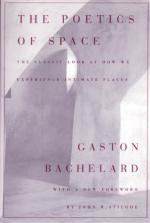
|
| Name: _________________________ | Period: ___________________ |
This test consists of 15 multiple choice questions and 5 short answer questions.
Multiple Choice Questions
1. How is Tom Thumb killed?
(a) By a grain of dust.
(b) By a snail.
(c) By the footsteps of a larger man.
(d) By the kick of an ant.
2. Which French scholar envisioned a fortress town based on the spiral design of shells?
(a) Robinet.
(b) Palissy.
(c) Bachelard.
(d) Michelet.
3. Baudelaire used the term "vast" to describe what?
(a) The infinity of intimate space.
(b) The variety of words and meanings.
(c) The language of poets.
(d) Intimate meaning, including synthesis, perspective, unity and movement.
4. What does Bachelard define as a coherent way to use reasoning to convincingly express primal images?
(a) A realistic painting or drawing.
(b) A fairy tale.
(c) A shell.
(d) A house.
5. How does Tom Thumb's stature become believable?
(a) Via personal experience.
(b) When seen through a magnifying glass.
(c) When described relative to a grain of dust.
(d) Via words in the pages of a book.
6. Contrary to the intellectual philosopher, states Bachelard, a poet may use words in what way?
(a) For sensitivity rather than precision.
(b) To describe the origins of man.
(c) For rhythm and rhyme, rather than meaning.
(d) To create false illusions.
7. A corner is a half-box between what two entities as described by Bachelard?
(a) Freedom and entrapment.
(b) Inside and outside.
(c) Vertical and horizontal.
(d) Flat and three-dimensional.
8. Who, according to Bachelard, sees everything as small from atop their towers of domination?
(a) Philosophers.
(b) Poets.
(c) Scientists.
(d) World leaders.
9. Which is the best description of Diole?
(a) Psychologist and ontologist of under-sea life.
(b) Pnemonologist.
(c) Poet and painter.
(d) Scientist and entrepreneur.
10. What image does Bachelard propose to give a door sacred character?
(a) A mythical threshold god.
(b) An elaborate molding.
(c) Elaborate locks and keys.
(d) Opaque peep holes.
11. While a phenomenologist accepts a poetic image, what will a psychologist do in the opinion of Bachelard?
(a) Reject the image.
(b) Analyze the origins of an image.
(c) Refine the image.
(d) Analyze the daringness of an image.
12. In the words of Bachelard, a mollusk that weighs fourteen pounds but with a shell that weighs five hundred or more pounds can be described in what way?
(a) An immense dream of nature.
(b) A miracle.
(c) A metaphor.
(d) An impossibility.
13. For Bachelard, what is the dichotomy of doors?
(a) Open doors function as windows.
(b) Doors can be opened into the world of men or into the world of solitude.
(c) Doors ajar offer no protection, no matter how solidly built.
(d) Doors invite inside, but also shut out.
14. How is Tom Thumb's influence transposed into the sky?
(a) His name was given to the small star that drives the Grand Chariot or Great Bear constellation.
(b) His spirit lives within the sun.
(c) His name was given to a star within the Little Dipper constellation.
(d) His name was given to a moon of Saturn.
15. What does Bachelard say makes miniatures of all things seen?
(a) Consideration of the nest and the shell.
(b) Thoughts of the universe's infiniteness.
(c) Distance to the horizon.
(d) Thoughts of death and afterlife.
Short Answer Questions
1. How does Bachelard refer to words?
2. For Bachelard, what allows language to return to free-form expression without old hardened metaphors?
3. What are two opposing truths introduced by Bachelard in "Corners" regarding corners?
4. What idea, prevalent in novels, did Sartre seek to illuminate?
5. According to Bachelard, what term can describe the emergence of being through poetry and contemplation of poetic immensity?
|
This section contains 595 words (approx. 2 pages at 300 words per page) |

|




